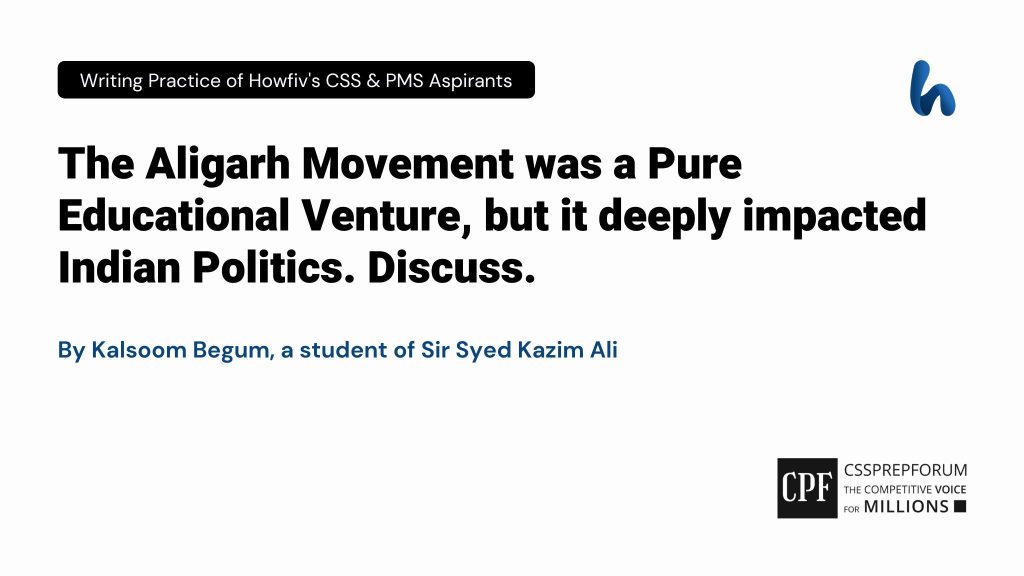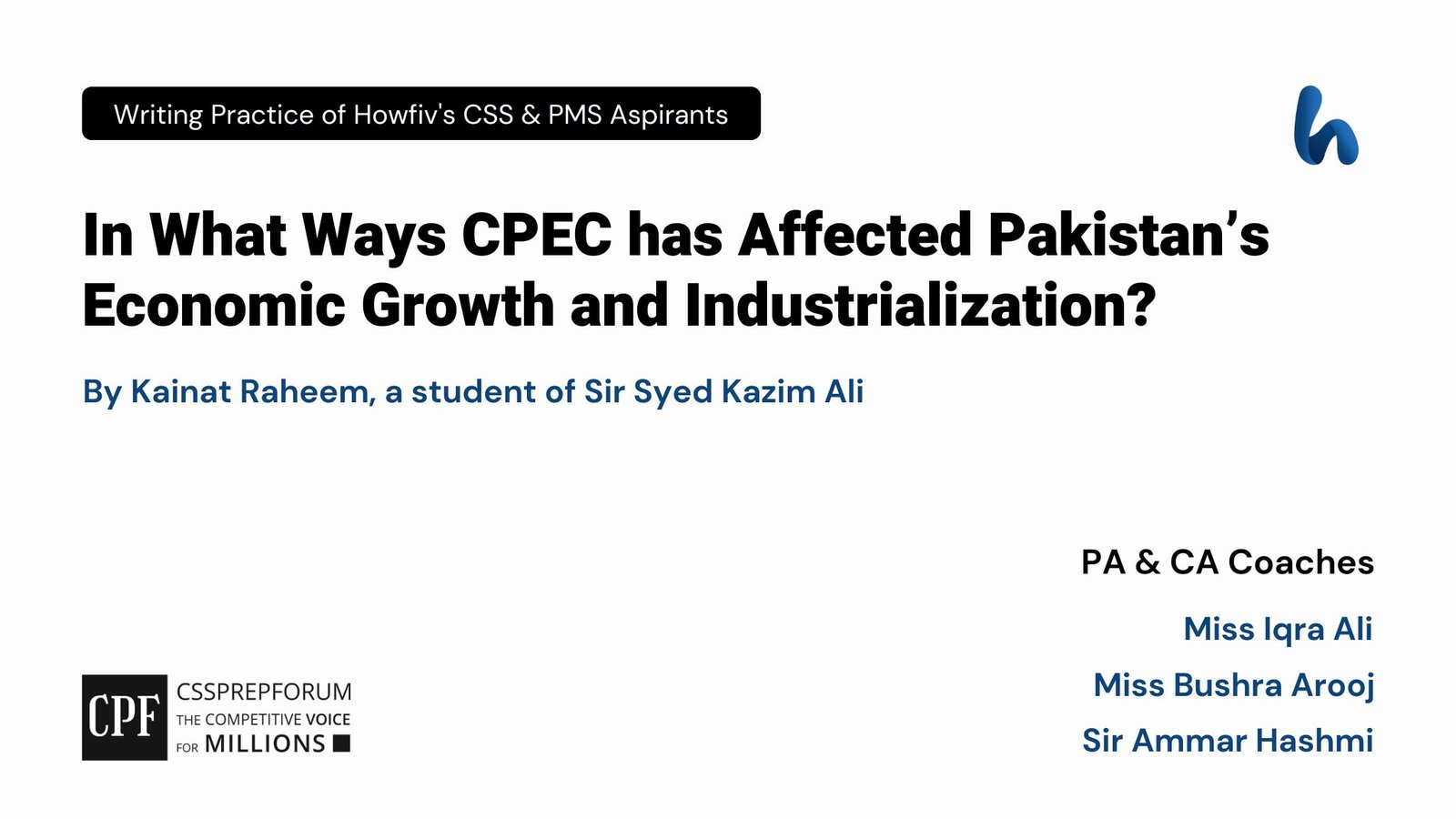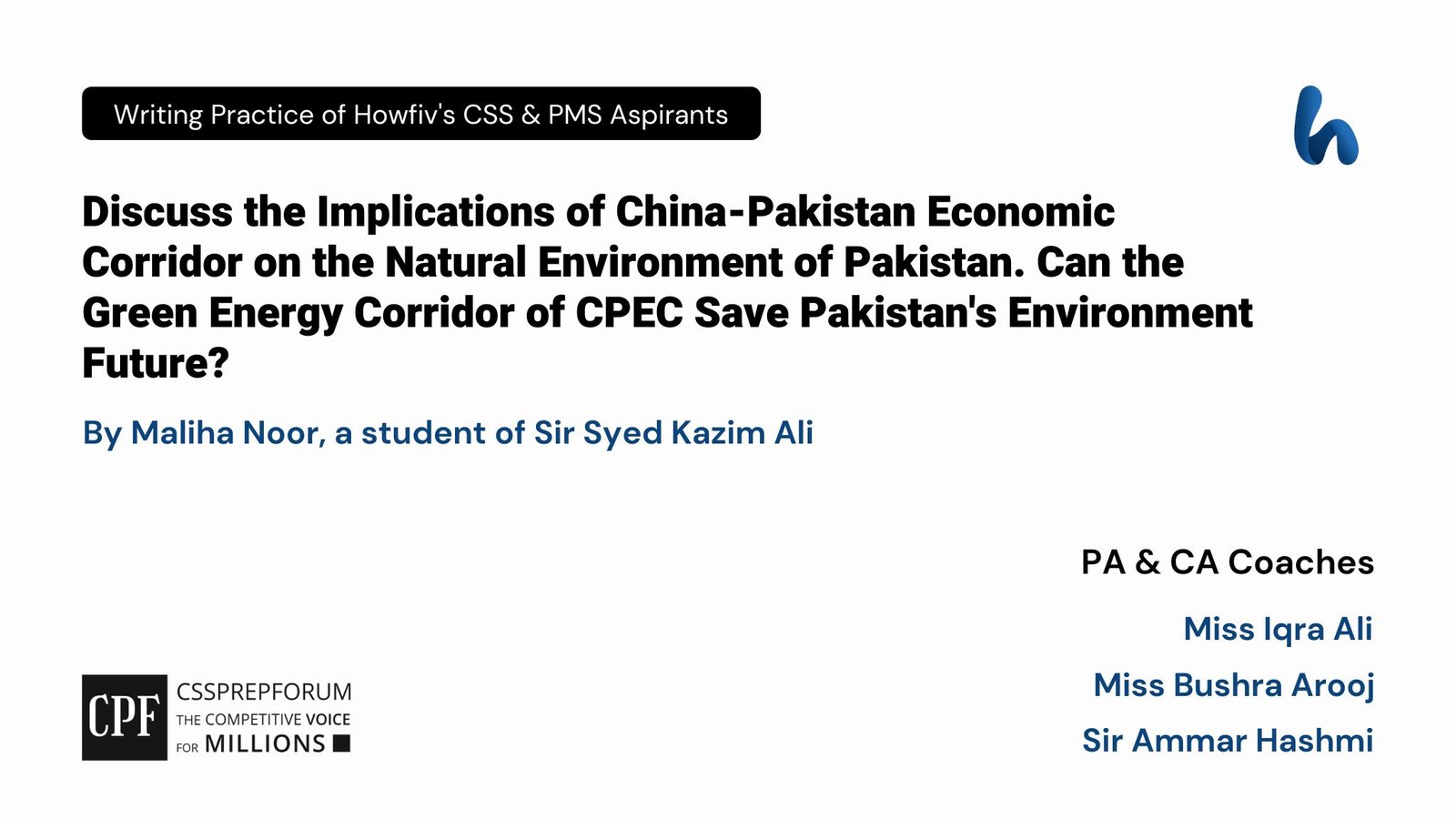The following article, “The Aligarh Movement was a Pure Educational Venture, but it deeply impacted Indian Politics. Discuss.” is written by Kalsoom Begum, a student of Sir Syed Kazim Ali. Moreover, the article is written on the same pattern, taught by Sir to his students, scoring the highest marks in compulsory subjects for years. Sir Kazim has uploaded his students’ solved past paper questions so other thousands of aspirants can understand how to crack a topic or question, how to write relevantly, what coherence is, and how to include and connect ideas, opinions, and suggestions to score the maximum.

Outline
1- Introduction
The Aligarh Movement initially started as an educational endeavour, aiming at bringing an intellectual renaissance to the Muslims of the Subcontinent. However, over time, it encompassed all other facets, such as substantially influencing the political scenario of British India by reconciling the relations between the British and the Muslims, developing the Two Nation Theory, and pioneering the major socio-political movements in India.
2- A brief overview of the socio-political conditions of the Indian Muslims
3- How did the Aligarh Movement Influence Indian politics during British Rule?
- ✓Rehabilitation of relations between Muslims and the British Raj
- Case in point: Publication of Risala-e-Asbab-e-Baghawat-e-Hind and the establishment of the British Indian Association and the Indian Patriotic Association
- ✓The Urdu Movement and the promotion of the Two Nation Theory
- Case in point: Hindus and Muslims can never evolve a common nationality, and this misconception of one Indian nation will lead India to ultimate destruction if we fail to revise our notions in time, M.A. Jinnah.
- ✓Opposition to Congress and the development of Muslim nationalism
- Case in point: India was not a single nation. Is it possible that under these circumstances, two nations — the Mohammedans and the Hindus — could sit on the same throne and remain equal in power?… To hope that both can remain equal is to desire the impossible and the inconceivable, Sir Syed Ahmed Khan.
- ✓The emergence of the Mohammedan Anglo-Oriental alumni as key players in the Khilafat and Pakistan movements
- Case in point: The Aligarh cricket ground and common rooms were breeding grounds for Muslim leaders, Stanley Woolpert.
- ✓Birth of the All India Muslim League
- Case in point: Formation of the Muslim League in the 20th session of AIMEC, an organization of the Aligarh movement.
4- Critical analysis
5- Conclusion

Answer to the Question
Introduction
The Aligarh Movement was one of the most prominent and influential Muslim reformist movements in the history of the Subcontinent. It was a pseudonym for Sir Syed Ahmed Khan’s untiring efforts for Muslim revival and intellectual renaissance. Although the movement was initially started as an educational endeavour, it gradually encompassed all other facets, significantly influencing the political scenario of 19th-century British India. From scratch, the Aligarh Movement, directly or indirectly, helped Muslims in their political empowerment. For example, it fostered a spirit of amity between Muslims and the British, and it granted the Muslims their long-sought political rights. However, following the formation of the Indian National Congress, Sir Syed adopted a blatant political stance and highlighted the Two Nation Theory. Moreover, the Aligarh Movement became the progenitor of several political movements, for instance, the Urdu Movement, the Khilafat Movement, and most significantly, the Pakistan Movement. The alumni of Mohammedan Anglo-Oriental College (MAO) and Aligarh Muslim University (AMU) rose to prominence as leaders of the independence struggle that culminated in the shape of Pakistan in 1947. Thus, the answer elucidates how the Aligarh movement not only initiated the Islamic Renaissance in the Subcontinent but also substantially changed the political landscape of British India for centuries to come.
A brief overview of the socio-political conditions of Indian Muslims
The 1857 War of Independence left the Muslims utterly stunned and paralyzed with deep scars on their identity, culture, and political might. They had been long asleep in the slumbers of nostalgia for past glory, and unlike Hindus, they were resistant to change. Moreover, the hostile and vengeful attitude of the British towards Muslims further inflamed the animosity between the two factions. At this point, Sir Syed Ahmed Khan emerged as a Messiah for the oppressed Muslim community of the Subcontinent. He helped them practically encounter the problems rather than bemoaning the shift in fortunes. The credit utterly resides with him for introducing Muslims to modern education and altering their socio-political mindset, saving the community from complete cultural and intellectual annihilation. As Ehsan Danish, the famous Urdu poet, mentions in his poem ‘To Sir Syed’s Spirit’,
“What was lit by the sparks within your chest
That secretly burning fire could not grow cold until now
Your foresight has granted lamps to the future
Despite this, the air is polluted by the smoke of the past until now.”
Impacts of the Aligarh Movement on Indian politics during the British Rule
Rehabilitation of relations between the Muslims and the British Raj
The Muslims were reluctant to accept the British Raj and viewed them as adversaries who ousted them from power. Similarly, the English considered Muslims to be the sole culprits behind the “Mutiny of 1756.” Sir Syed tried to mediate the conflict by publishing Risala-e-Asbab-e-Baghawat-e-Hind in 1858 to exculpate the Muslims of their alleged role in the rebellion. He argued that the mutiny was equally instigated by the dictatorial character of the British government and their ill-informed conceptions of Indian society. However, the magazine initially infuriated the government following the English translation of Auckland Colvin and Major General Graham. It started to fulfil its intended motifs of reconciliation between the two parties. Moreover, the Aligarh Movement also established the ‘British Indian Association’ in 1886 and the ‘Indian Patriotic Association’ in 1888, which also served as the instruments of appeasement to the English government. Consequently, the British started to grant Muslims their political rights and include them in the governmental education and employment policies.
The Urdu Movement and Two-Nation Theory
The Aligarh Movement also played a crucial role in the Urdu-Hindi controversy 1867, which sought to downplay Urdu as an official language. Sir Syed Ahmed Khan and his companions emerged as staunch opponents of this claim and fervently supported Urdu as a national lingua franca among the Muslim populace throughout the Subcontinent. It was under the theoretical framework for promoting the Urdu Movement that Sir Syed developed his famous ‘Two Nations Theory’. He was of the view that the Hindus and Muslims can never be a single nation as they profoundly differ in their cultures, languages, religions, literature, and social practices. History is a testament to the fact that Sir Syed Ahmad Khan’s theory served as the fundamental ideology behind the demand for Pakistan. In the words of Quaid-e-Azam, “Hindus and Muslims can never evolve as a common nationality, and this misconception of one Indian nation will lead India to ultimate destruction if we fail to revise our notions in time.”
Opposition to Congress and the development of the Muslim nationalism
The establishment of the Indian National Congress (INC) in 1885 stirred the core of Indian politics. Sir Syed’s political strategy proposed aloofness from the active politics of India and discouraged Muslim participation in Congress. He opined that Muslims were not intellectually capable enough to enter regional politics temporarily. Besides, his farsightedness enabled him to discern the true motifs of Congress as a pro-Hindu entity. Speaking in Meerut in March 1888, Sir Syed said, “There was no such thing in India as one nation; Is it possible that under these circumstances two nations — the Mohammedans and the Hindus — could sit on the same throne and remain equal in power?… To hope that both can remain equal is to desire the impossible and the inconceivable.” Thus, the Aligarh Movement initiated a sense of Muslim nationalism among the oppressed Muslims of India, and they started to see themselves as separate political entity with separate definitions of ‘nation’ and ‘freedom.’
MAO and AMU Alumni as the pioneers of the Khilafat and Pakistan Movements
Another phenomenal political impact of the Aligarh Movement was the rise of the intellectual Muslim class in India, which vehemently advocated the Muslim political cause in multipolar India. The Aligarh Institute provided its students with firm grounds to enhance social interaction and develop political ideology. As a result, the alumni of MAO and AMU, such as Nawab Mohsin-ul-Mulk, Nawab Waqar-ul-Mulk, Sir Ziauddin Ahmed, and Ali brothers, became the political voice of millions of subjugated Muslims in India. This leadership successfully pioneered both the Khilafat movement (1919 –1924) and the Pakistan movement. According to Stanley Woolpert, an American historian, “Aligarh cricket ground and common rooms served as a breeding ground for Muslim leaders.” Similarly, Quaid-e-Azam also paid a handsome tribute to the AMU students when he described the university as “the arsenal of Pakistan”. These political leaders not only empowered the Muslims but also united them on a single platform to fight for their socio-political rights, which eventually resulted in the formation of Pakistan.
Birth of All India Muslim League
Last but not least, in addition to infusing Muslims with a sense of political emancipation, the Aligarh Movement among Muslims is also accredited with forming a separate political party. Sir Syed established the All India Mohammedan Education Conference (AIMEC) as a mere educational venture in 1886. Nevertheless, it became the national symbol of Muslim unity and congruence throughout the Subcontinent. Following the Congress-sponsored partition of Bengal in 1905, the leadership of AIMEC found it indispensable to create a political party of their own, which would fight for the rights of the Indian Muslims. Consequently, the All India Muslim League, formed in the 20th session of AIMEC on Dec 27, 1906, in Dhaka, became the first and sole representative of the Muslims of the Subcontinent. In a nutshell, Pakistan, in many aspects, owes its existence to the rehearsal of a singular nationalist framework having emerged from the Aligarh Movement.
Critical Analysis
To critically view, Sir Syed’s Aligarh Movement has attracted multifarious criticism from supporters and opponents. Some critics call it a ‘luminous star in the dark’; others call it a ‘British conspiracy.’ Regardless, the campaign remains one of India’s most noteworthy revivalist moments. Its role in the intellectual, social, and political empowerment of Indian Muslims cannot be subdued. The political aspects of the movement are directly linked with the birth of Pakistan. In the words of Nadeem F. Paracha, a Pakistani journalist, “Pakistan nationalism is the direct outcome of Muslim nationalism whose intellectual pioneer was Sir Syed Ahmad Khan.” Hence, it would not be unfair to say that the Aligarh Movement was the first step taken by the then-Indian Muslims towards the establishment of Pakistan.
Conclusion
To cut a long story short, the Aligarh Movement was a broad reformist endeavour that profoundly impacted every aspect of the life of a common Indian Muslim. It sprouted life in the dormant Muslim civilization. It paved the way for the Islamic revival that significantly affected the religion, politics, culture, and, most importantly, politics of the Indian Subcontinent. The Aligarh Movement helped Muslims regain their lost respect and rekindle their relationship with the British authorities. Moreover, it helped Muslims identify themselves as a separate entity and empowered them to fight for their political rights. It also created a class of educated Muslim leaders who spearheaded several socio-political movements in India, the result of one being Pakistan itself. Thus, the influence of the Aligarh Movement on Indian politics is so deep-rooted that it changed the social and political landscapes in the Sub-continent.

CSS Solved Past Papers’ Essays
Looking for the last ten years of CSS and PMS Solved Essays and want to know how Sir Kazim’s students write and score the highest marks in the essays’ papers? Then, click on the CSS Solved Essays to start reading them.
CSS Solved Essays
CSS Solved General Science & Ability Past Papers
Want to read the last ten years’ General Science & Ability Solved Past Papers to learn how to attempt them and to score high? Let’s click on the link below to read them all freely. All past papers have been solved by Miss Iqra Ali & Dr Nishat Baloch, Pakistan’s top CSS GSA coach having the highest score of their students. General Science & Ability Solved Past Papers
Articles Might Interest You!
The following are some of the most important articles for CSS and PMS aspirants. Click on any to start reading.












